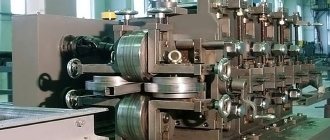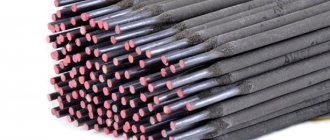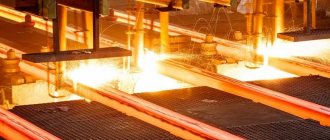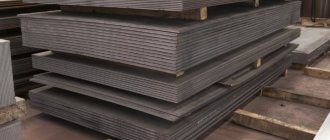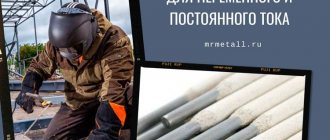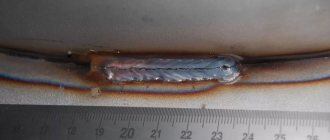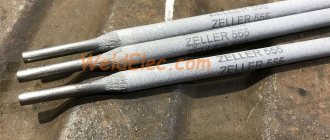Welding low alloy steels has found wide application in the manufacture of structures in construction. This is due to the fact that low-alloy structural steels have increased strength and, due to this, metal structures are lightweight and, therefore, more economical.
As a rule, the weldability of low-alloy structural steels is satisfactory. But, it is necessary to take into account that when the carbon content in the steel composition is more than 0.25%, there is a risk of the formation and development of hardening structures and hot cracks in the weld. In addition, other weld defects, such as the formation of pores, are likely to occur. And this happens due to carbon burnout during welding.
What electrodes should be used to cook steel 09g2s
Due to its properties (small percentage of alloying components), low-alloy steel grade 09g2s does not overheat and is not hardened during welding.
This makes it possible to weld steel and structures made from it with a wide range of welding electrodes. Electrodes for welding low-alloy steels of grade 09 g2s with a temporary tensile strength of up to 60 kg/cm2 are designated “U”. (GOST 9467-75)
For manual welding use:
Electrodes UONII 13/45 (E 42a)
These electrodes are used to weld structures made of steel 09g2s, which have special requirements. And especially when welding in very low outside temperatures. The weld metal requires more stringent strength indicators.
The electrodes are characterized by minimal metal sputtering during welding.
Electrodes are selected depending on their linear size, which is associated with their diameters: from 300 mm to - 450 mm.
The diameter value and position of the switch determine the current strength (in A.)
According to reviews from welders, these electrodes have less impact on the quality of the deposited metal and do not deteriorate its properties. They also have excellent carbon removal ability.
The welded seams can withstand significant loads, which distinguishes these electrodes from others.
Electrodes UONII13/55 S (E 50a)
These electrodes are also used to weld structures made of steel 09g2s, which have special requirements. And especially when welding in very low outside temperatures (even in the Arctic). After welding with these electrodes, the weld metal meets the corresponding more stringent standards for ductility and impact strength.
With these electrodes it is possible to make welding seams in any location in structures. They operate on reverse direct current.
The weld metal contains a small percentage of hydrogen and has increased resistance to cracking. They are distinguished by excellent self-separation of slag.
Welding is carried out with a short arc on surfaces that are free of grease and other contaminants.
The diameter and position of the seam determine the current strength (in A.)
Electrodes can develop porosity if the arc is extended across an oxidized surface.
These electrodes are used to weld structures and parts made of steel 09g2s in all seam locations. The exception is a vertical seam from top to bottom. Electrodes operate on current of any polarity from power sources with a voltage of at least 65 V. They are distinguished by their ease of use; even a beginner in welding can use them. This is a budget welding option with very good quality indicators.
Welding of rusty, damp, or insufficiently cleaned metal is allowed. They have fairly high welding performance.
Welding of seams of structures and rolled products of medium and large thicknesses in the lower location of the structure is carried out at higher modes.
They weld with electrodes over a short arc length, but welding is also allowed over a medium arc length.
Electrodes coated with titanium oxide (rutile) are successfully used for welding parts and structures made of steel 09g2s in all planes. This is especially important for welding in vertical seams... Because These electrodes do not emit toxic gases when welding.
When working with these electrodes, welding time is reduced.
The electrodes operate on direct current and alternating current. These electrodes can even weld oxidized structures, while maintaining the beautiful appearance of the seam.
They are used primarily in critical structures.
Source
How to cook stainless steel semi-automatically
Often, connection parts may be located in hard-to-reach places. Semi-automatic welding of stainless steel provides a reliable seam that is protected from premature wear.
Metal preparation
Before performing work on connecting with filler wire, it is necessary to prepare the parts:
- remove all contaminants at the connection point;
- degreasing the metal is carried out to ensure the reliability of the seam and protection from cracks; solvents will help with this;
- To remove excess moisture, it is recommended to heat the parts to 100°C.
Welding technical diagram
Three methods are used to join stainless alloys by welding:
- for parts of small thickness, the short arc method is required;
- with jet transfer, a welded stainless steel joint is obtained for parts of large thickness;
- The impulse method is considered universal.
The technological process requires following certain rules:
- for a good view it is necessary to place the burner at a negative angle to the seam;
- the head should be kept at a distance of 12 mm from the metal surface;
- the wire should melt in small portions, without large drops.
The welder is recommended to fulfill a number of requirements:
- welding is carried out with reverse polarity of the terminals;
- the angle value regulates the quality and width of the seam;
- the extension length of the filler wire should be no more than 12 mm;
- dried gas must be supplied to the weld site at a flow rate of up to 12 m3/min;
- to prevent splashes, the surfaces are treated with a chalk solution;
- It is recommended to make the beginning and end of the seam at some distance from the edge of the parts.
Correction of defects
When performing welding work, deformations may occur at the joints; this occurs as a result of heating. To resolve this, do the following:
- when bubbles form at the seam, use the method of tapping with a hammer from the edge of the parts;
- warped metal must be straightened by heating the part with a torch, as well as tapping with a hammer.
To obtain a seam, it is necessary to study the theoretical part, as well as perform test welding on samples.
Welding technology for carbon and low-alloy steels
Carbon steels include a class of alloys in which carbon (C) as a chemical element is the main alloying component that determines the most important properties of the metal. Its share in the composition can be different, depending on it, groups of these steels are distinguished:
- low-carbon - the proportion of C in them is less than 0.25%;
- medium-carbon - with a carbon share from 0.25 to 0.6%;
- high-carbon - with a carbon share from 0.6% to 2.07%.
Also, the composition of such steels includes manganese and silicon in very small quantities - as useful alloying elements, and hydrogen and sulfur as harmful impurities.
Process Features
Low-alloy steel is a material belonging to the group of satisfactorily weldable metals that are joined by almost all types of welding.
- equal seam strength;
- obtaining the required form;
- no defects.
Welding low-alloy steel is more difficult than low-carbon structural steel. It is more sensitive to thermal influences. It should be taken into account that a content of more than 0.25% carbon in the material can lead to the formation of hardening structures and cracks in the weld, and carbon burnout can lead to the formation of pores.
To avoid the formation of hardening martensitic structures, the part is heated, multilayer welding is used, observing a minimum time interval between the application of metal layers to the seam. The material of the coated electrodes is selected with a low content of phosphorus, carbon and sulfur. This helps to increase the resistance of the seam against crystallization cracks.
Connection of chromium-silicon-manganese steels
This type of low alloy steel is also called chromansil. The composition includes carbon 0.17-0.4%, manganese 0.8-1.1%, silicon and chromium - 0.9-1.2%. The material is inexpensive, has good elasticity and strength, and can withstand vibration. Disadvantage: poor heat resistance.
Preparation for welding
Carbon and low-alloy steels are cut into blanks by gas, plasma or air-arc cutting, followed by cleaning of heating areas with cutting or abrasive tools until traces of fire cutting are removed.
Before assembling the joint, the edges to be welded to a width of 20 mm are cleaned to a metallic shine and degreased.
The joints are assembled using assembly jigs or using tacks. They are installed using filler wires of the same brand that will be used to weld the root seam.
The height of the tack should be equal to 0.6-0.7 of the thickness of the parts being welded, but not less than 3 mm, with a wall thickness of up to 10 mm, or 5-8 mm with a wall thickness of more than 10 mm.
Tack welding must be done with full penetration. Their surface must be thoroughly cleaned. Tacks with unacceptable defects should be removed mechanically.
The welding wire is calcined for 1.2-2 hours at a temperature of 150-250°C. Rust on the wire dramatically reduces the stability of the welding process. It is recommended to remove rust by etching the wire in a 5% solution of hydrochloric acid, followed by calcination for 1.5-2 hours at a temperature of 150-250°C.
The best way to weld a heating system
When it's time to change the heating system at home, you can't do without welding. Here you will need rods that can create a fairly strong seam.
This could be SSSI 13\45 with a diameter of 3 mm. They are sensitive to rust, so the part you are going to work on will need to be thoroughly cleaned. Weld with a short arc.
The pipe welding process is very complex, the nuances of which can be understood by a specialist. Only an experienced welder can accurately determine which electrodes to use. The list of recommended rods includes: E42A, E-09X1MF and TsL-20.
Selecting welding mode parameters
Welding is performed using direct current of reverse polarity.
The diameter of the electrode wire is selected depending on the type of welded joint, the thickness of the metal being welded and the position of the seam in space.
Dependence of wire diameter on connection type and metal thickness
| Wire diameter, mm | Metal thickness (mm) for connections | Seam position in space | ||
| corner | ||||
overlap
Carbon dioxide welding modes for low-carbon and low-alloy steels
| Compound | Dimensions, mm | Welding current, A | Arc voltage, V | Welding speed, m/h | Wire diameter, mm | Electrode extension, mm | Gas consumption, l/min | Number of passes | |||
| S | b | ||||||||||
| 0,8-1 1,5-2 3 | 0-0,3 0-0,8 0-1 | 50-80 90-200 200-380 | 17-18 18-22 23-25 | 25-50 25-55 25-110 | 0,7-0,8 0,8-1,2 1,2-1,4 | 8-10 8-13 12-15 | 6-7 6-7 8-11 | 1 | |||
| 4 6 8 10 14 | 0-1,2 0-1,5 0-1,5 0-1,5 0-1,5 | 200-350 250-420 300-450 320-470 380-500 | 23-32 25-36 28-38 29-38 33-40 | 25-50 25-55 25-110 | 0,7-0,8 0,8-1,2 1,2-1,4 | 8-10 8-13 12-15 | 6-7 6-7 8-11 | 1 | |||
| 16 18 | 0-1,5 0-1,5 | 380-500 380-500 | 33-40 33-40 | 16-25 12-25 | 1,4-2,5 1,6-2,5 | 15-25 18-25 | 12-16 12-18 | 2 | |||
| 20 | 0-1,5 | 380-420 450-500 | 32-36 36-40 | 14-16 18-20 | 1,6-2,5 | 18-25 | 12-18 | 2 | |||
| 380-420 450-500 350-400 | 32-36 36-40 33-36 | 18-20 | 1,6-2,5 | 18-25 | 12-18 | 3 | |||||
| 24 | 0-1,5 | 380-420 450-500 350-400 | 32-36 36-40 33-36 | 18-20 | 1,6-2,5 | 18-25 | 12-18 | 3 | |||
| 380-420 350-400 480-500 350-400 | 32-36 33-36 38-40 33-36 | 16-18 | 1,6-2,5 | 18-25 | 12-18 | 4 | |||||
| 32 | 0-1,5 | 380-420 350-400 480-500 350-400 | 32-36 33-36 38-40 33-36 | 14-16 | 1,6-2,5 | 18-25 | 12-18 | 4 | |||
Features of welding carbon steels
The key requirement when welding parts made of carbon steels is the strength characteristics of the weld metal and heat-affected area: they must correspond to the characteristics of the base metal. The higher the proportion of carbon, the more difficult it is to obtain a compound that strictly meets this requirement. Therefore, each group of carbon steels has its own welding characteristics.
Welding low carbon steels
This is a group of highly weldable, most ductile carbon steels due to their low carbon content and alloying additives. Welding can be performed using any known technologies, including manual electric arc welding. However, this chemical composition of the metal also causes its own characteristics: if the electrode is chosen incorrectly, there is a risk that the weld metal will be stronger than the metal of the part, which can negatively affect the overall strength of the structure. And when performing multilayer welding, increased fragility of the weld metal is possible. To avoid these problems, electrodes with rutile and calcium fluoride coatings are usually used for welding, and a proportion of iron powder is added to the coating. Among the low-carbon steels widely used for professional welding are the grades MR-3LUKS, MR-3, OZS-4, ANO-4, ANO-21, OZS-12, MK-46.00, UONI-13/55, UONI 13/45, SSSI 13/85.
To obtain the necessary strength properties, the weld metal is forged and calcined after welding.
Electrodes for medium carbon steels
The amount of carbon in such alloys is greater, and accordingly, the welding process is more complicated. The downside is that the metal of the welded joint and the metal of the part may have different strengths. In addition, the metal near the edges of the seam can turn out to be very brittle and with characteristic cracks. To avoid this, electrodes with a sufficiently low carbon content are used.
Particular attention should be paid to the edges of the parts being connected. They must be cut to avoid metal penetration, which can be caused by high currents - they are necessary for heating the parts being connected. You should also take into account: to improve the quality of the weld, the parts, as mentioned above, are preheated and heated during the welding process;
- It is better to move the electrode not across, but along the joint;
- welding is best performed with a short arc;
- After welding, for greater strength, the seam is also forged and heat treated.
Among the well-known electrodes that are used for welding medium-carbon steels are grades UONI-13/55, UONII 13/55, UONII 13/45A, UONI-13/65.
Welding high carbon steels
Such steels have a high carbon content, which practically makes them unsuitable for welding various structures. Welding work, as a rule, is performed only when repairs are necessary. In this case, the same technologies are used as when welding medium-carbon steels. The metal in the weld area is preheated to 250-300 °C; upon completion of welding, the weld is forged and heat treated. Two more conditions must be observed - welding is possible at a temperature not lower than -5 degrees Celsius in a room where there are completely no drafts.
Welding electrode for gas welding
What characteristics should rods have for welding a pipe intended for a gas main?
Let's highlight several brands: OK-46, LB-52 and UONI-13\55. Rods of the OK-46 brand are considered universal, as they have a rutile coating. The listed consumables are well suited for parts with a wide gap, as well as for tubing work.
Let us mention one more electrode - LB 52U low-conductivity group with the main type of coating. Containing a small amount of hydrogen allows for a particularly strong weld, used for gas and oil pipelines made of durable steel.
When working with such a source material, the arc remains stable and completely penetrates the metal.
ESAB MTK-01K welding rods provide a decent level of seam in difficult areas, for example, such as rotary and non-rotary joints.
They can be used on parts made of carbon and low alloy steel. Suitable for operation on both direct current, direct and reverse polarity. Welding is easy, the arc burns stably, and there is minor metal spattering.
Welding technique
Butt joints of metal with a thickness of 0.8-1.2 mm are welded on copper or ceramic linings. Metal with a thickness of more than 1.2 mm can be welded by weight.
Structures with a wall thickness of up to 3 mm are welded in one pass without cutting the edges. It is advisable to weld in a vertical position from top to bottom. Welding is carried out with periodic interruptions of the process or in pulse mode.
Metal with a thickness of 4 mm or more is welded on both sides without cutting the edges, but with a gap. Welding in the lower position is carried out in the direction from left to right - “backward angle” or from right to left - “forward angle”. Vertical seams with a metal thickness of up to 3 mm are welded from top to bottom, and over 3 mm - from bottom to top.
When multi-pass welding of butt and T-joints to ensure penetration, the first pass is performed with a gap of up to 0.5 mm without transverse vibrations of the torch, and with a gap of more than 0.5 mm - with transverse vibrations. The second and subsequent passes are performed only with transverse vibrations. Subsequent seams are applied after cleaning the slag crust from the previous seams.
When welding at high current conditions, for high-quality crater filling, you need to reduce the welding current to 150-170 A, and the arc voltage to 24-26 V.
What rods will be needed to install a water pipeline?
Installation of water pipes is one of the most common types of work. For connecting pipes, it has become better to select electrodes with a diameter of 2-3 mm, brands MN-5, MNZh 5, NZH 13, MNCh-2.
When you need to make a vertical seam, we recommend MNCh-2 electrodes. For operation in cold and hot modes - TsCh-4. When selecting electrodes, pay attention to the coating; for water pipes it should be thick.
Buy rods with coating, they will help protect against excess oxygen.
Steel 09g2s - characteristics, application and properties of steel 09g2s
Steel 09g2s is a very popular steel, used both in construction and in many industries. There are domestic and foreign analogues of this type. It is most often used for the manufacture of pipes, rolled metal and welded metal structures, the temperature range of which is from -70 to 4250C9 with permissible loads on them).
Steel 09g2s 12: decoding
Understanding how labeling is formed allows you to clearly understand what product the manufacturer represents, as well as its main features. For those who are interested in details about 09g2s, the breakdown of steel is as follows:
- 09 – quantitative fraction of carbon content in the alloy (0.09%);
- G2 is manganese and its part in the entire volume fluctuates around 2% (the exact figure ranges from 1.3 to 2%);
- C - denotes silicon, the absence of numbers after the symbol indicates that it is less than 1%.
Thus, the decoding of 09g2s clearly looks like this:
| Element | , % |
| C (carbon) | up to 0.12 |
| Si (silicon) | 0,5 – 0,8 |
| Mn (magnesium) | 1,3- 1,7 |
| Ni (nickel) | up to 0.3 |
| S (sulfur) | up to 0.04 |
| P (phosphorus) | up to 0.035 |
| Cr (chromium) | up to 0.3 |
| N (nitrogen) | up to 0.008 |
| Cu (copper) | up to 0.3 |
| As (arsenic) | up to 0.08 |
| Fe (iron) | 96-97 |
As can be seen from the table, the interpretation of steel 09g2s is not limited to only three alloying components. In addition to carbon, silicon and manganese, it is supplemented by the following elements: nickel, sulfur, phosphorus, chromium, nitrogen, copper, etc. The percentage component of alloying metals is no more than 1-2 total%.
Marking 09g2s on a steel sheet
Also, for steel 09g2s, not only the alloying level is taken into account, but also other factors. Here are just a few of them that are significant for a particular case:
- constructiveness (purpose);
- eutectoid (structure: hexagonal, cubic, etc.; changes after hardening, etc.);
- production method (open hearth, conventional or electric steel);
- chem. steel composition 09g2s (in this case low-alloy).
As a result, analogues appear in relation to which questions like the following are often asked: is 345 steel 09g2s ? The designation C345 was introduced for builders , where the numbers do not indicate the chemical composition of the material, but its important property - the yield strength; for steel 09g2s it corresponds to the construction standards C345, which is reflected in a number of GOSTs (27772-88).
Below, several classic options are considered, including when one grade of steel corresponds to several strength classes.
Technical characteristics: subtleties of using reference manuals
The properties of 09g2s steel are largely determined by the chemical composition of the alloy, its specific parameters, which today are quite accurately calculated by metallurgists.
Steel grade 09g2s has the following critical points :
- Ac1 = 732, when austenite transforms into pearlite during cooling processes;
- Ac3(Acm) = 870 (s – from French chauffage/heating) the end point of cementite dissolution;
- Ar3(Arcm) = 854 (refroidissement – cooling) the beginning of the release of Fe3C;
- Ar1 = 680 hypoeutectoid steel, corresponds to ferrite precipitation
The symbols are classic, numbers 1 and 3 indicate the numbers of points on the graph. The symbols cm usually mark hypereutectoid steels.
If we talk about other features of St 09g2s, the following characteristics are noted: easy weldability of the material . For this purpose, RDS, ADS under flux and gas protection are used. Only products that have undergone chemical-thermal treatment cannot be welded.
The mechanical properties of steel 09g2s are tabular values that were developed by a number of GOST standards and describe the material at room temperature, as well as for its other states.
Among the important mechanical properties of 09g2s steel are the following:
- Yield strength for permanent deformation, measured in MPa;
- Relative values of elongation at break and contraction;
- Impact strength (use under load is one of the main applications);
- Brinell hardness (HB).
Strength class of steel 09g2s: the table for the list of grades includes the one indicated, which, as already noted, corresponds to C345 . This also includes a number of other brands. Thus, steels that are different in chemical composition and even in the method of producing steel can have the same strength class. This data can be found for 09g2s according to GOST 19281-2014; the characteristics of the alloys are presented in convenient tables that are easy to navigate. You can view (download) GOST 19281-2014 here .
State standard
The key requirements for the physical and chemical properties of steel 20 are contained in GOST 1050-2013. The existing regulatory documents also contain an indication of the form in which this steel should be supplied from the plant - in the form of semi-finished products (coils, sheets) or in the form of finished products (angles, channels, pipes, rods and others available to the manufacturer subject to technological processes).
GOST 1050-2013 “Metal products from unalloyed structural high-quality and special steels” came into force on January 1, 2015 and is intended to carry out interstate regulation of the processes of manufacturing metal products made by hot rolling, forging, calibration, as well as for products with special surface preparation, which will be used in various industries.
Welding technology for steel of various structural classes
The composition of the alloy affects the structure of its crystallization lattice.
On this basis, steel is divided into 5 classes:
- austenitic;
- pearlite;
- martensitic;
- ferritic and carbide.
Austenitic steels
Chromium-nickel and some other alloys have this structure.
The main difficulty in welding is intergranular corrosion in the heat-affected zone, caused by the release of chromium carbides.
This defect cannot be eliminated by preheating.
You need to do the following:
- Use materials with a minimum concentration of carbon.
- If the proportion of a given element must be high according to technical specifications, use an alloying additive with similar properties (tungsten, tantalum, titanium, vanadium, zirconium).
Pearlitic steels
The most common variety. This includes carbon and low-alloy steels. A distinctive feature is the formation of martensitic structures in the suture part.
The condition for a high-quality connection is preheating and subsequent heat treatment.
This entails significant costs, so welding of carbon and low-alloy steels with a pearlite structure is resorted to only as a last resort.
Pearlitic steels contain any amount of carbon, but less than 2.14%.
Tool alloys
These materials contain large amounts of nickel, chromium and molybdenum. They are used to make cutting tools or their edges that experience heavy loads. Therefore, welding must ensure equal strength of the weld and the base metal.
Narrow-profile electrodes corresponding to the given steel grade are used. UONI-13/NZH/20ZH13 are suitable for most.
Heterogeneous types of one structural class
Pearlitic steels with different concentrations of alloying elements are cooked according to the following rules:
- The consumables are selected according to the least alloyed alloy.
- Mode and temperature - according to the most.
- If there is no possibility of preliminary and accompanying heating, the edges are fused. For this purpose, the most alloyed material is used in the form of an E42A type electrode. The thickness of the deposit must be such that the base metal does not heat up to the hardening temperature.
Different types of martensitic, ferritic and ferritic-austenitic steels with a high chromium content are cooked according to the following rules:
- The heating temperature is selected according to the material most prone to hardening.
- Complete cooling of workpieces is excluded.
- Ferritic-austenitic class welding materials and technology with minimal specific heat input are used.
- Upon completion of the heat treatment, the structure is quickly cooled.
It is more difficult to ensure high quality when welding using austenitic consumables, since during heat treatment, due to the difference in the temperature expansion of the weld and the base alloy, excessive stresses arise in the joint zone.
How to weld tubing pipes
When working with pump and compressor pipes, you will need special electrodes that can cope with a rather complex task. We can recommend UONI brand rods 13\45 or 13\55.
Such electrodes are used for carbon and low-alloy steel parts. And tubing pipes are made of especially durable metal.
The seam using UONI brand products can withstand dynamic loads at low temperatures and high pressure.
The correct selection of electrodes for welding is very important, but the welding machine you use also largely depends.
An experienced specialist with a good amount of knowledge and experience can help you understand the intricacies of welding. And the correct selected mode on the equipment will ensure a positive welding outcome.
